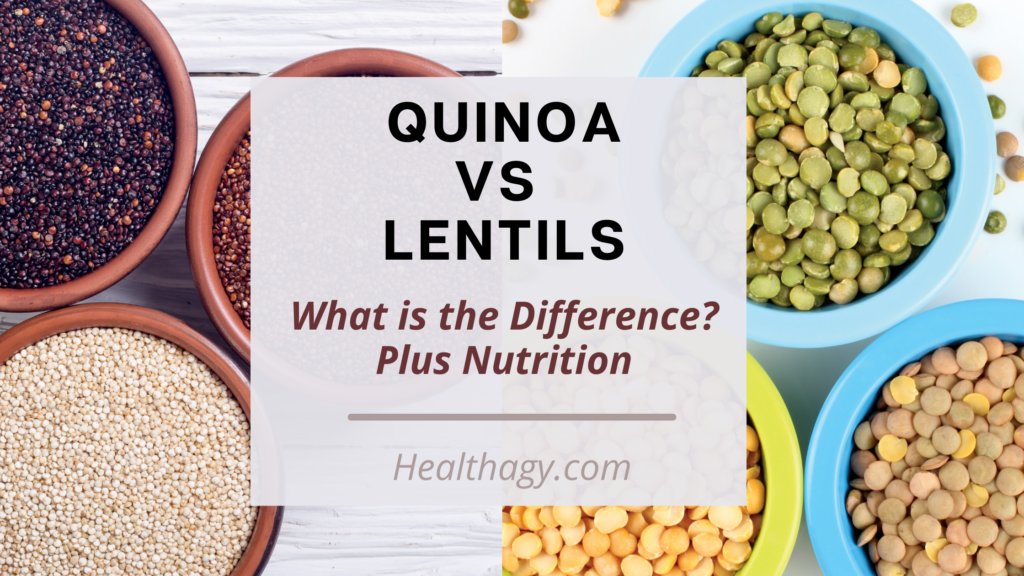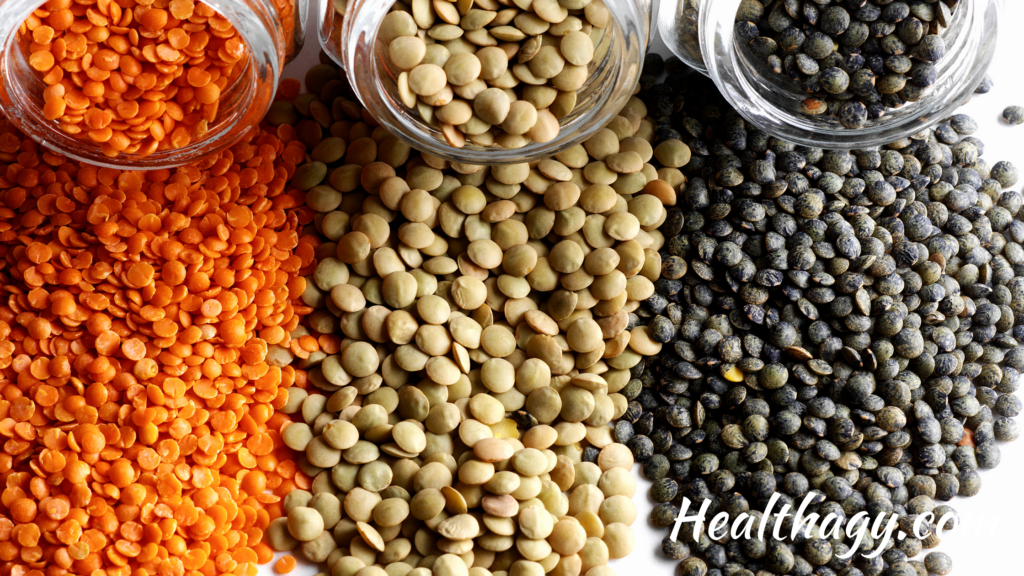
Quinoa and lentils are two popular sources of protein and great for anyone eating a plant-based diet. Both are excellent sources of fiber and protein while also being gluten-free. Both have a somewhat bland, nutty to neutral taste, pairing well with many main dishes. And to top it off, they are inexpensive, especially when purchased in bulk, and readily available at most grocery stores. Which leaves the question: What are the differences between quinoa and lentils? And which one is healthier and more nutritious for you?
Key Differences in Quinoa vs Lentils
Quinoa and lentils are both seeds. Quinoa is a pseudo-grain and recognized as a whole grain. Lentils are legumes. They both have a mild nutty taste. Quinoa is light and fluffy when cooked. It complements any dish as a substitute for rice and goes well on top of a garden salad for added texture, protein, and fiber.
Lentils go great in stews and soups, they are heavier in taste and texture than light and fluffy quinoa. They can also serve as a substitute for rice as a side dish. The flavor of lentils will vary based on the color and type of lentil it is. A few common varieties and their flavor qualities are listed further down in this post.
The main nutritional difference between quinoa and lentils is that lentils have about twice as much protein and fiber per serving as quinoa does. Quinoa is a complete source of protein, while lentils are limited in some essential amino acids. Overall lentils have higher nutritional values for vitamins and minerals than quinoa does.

What is Quinoa?
Quinoa is an ancient grain, dating back thousands of years. Technically a seed, it is nutritionally more like a fiber-rich whole-grain also called a “pseudo-grain”. Quinoa is packed full of protein, a great source of fiber, and various vitamins and minerals, which makes it a “superfood.”
Quinoa Taste
In general, quinoa has a slightly bland yet nutty flavor. Quinoa comes in a few varieties or colors, white is the most commonly found followed by red and black quinoa. While they all have a similar taste, they do have slight variations in texture and taste.
White quinoa is the most common, having a light texture and delicate taste it cooks up the fluffiest of all the colors. Red quinoa has a richer taste and heartier texture. It is slightly chewier and has a slightly nuttier flavor. Black quinoa has more of a slightly sweet, earthier flavor than white quinoa.

What are Lentils?
Lentils are grain legumes, also known as a “pulse.” You may know some other legume members such as beans, chickpeas, soybeans, and peanuts. Much like quinoa, lentils date back thousands of years.
Lentils are considered a grain-legume, which is also known as a “pulse.” While they are heart-healthy and unrefined, they are not technically a whole grain.
Lentils are heart-healthy legumes, a good source of magnesium and folate. Lentils are also an excellent source of protein and a good source of several vitamins and minerals such as iron, vitamin C, vitamin E, vitamin K, pantothenic acid, folate, and selenium.
Lentils are not a significant source of all essential amino acids to make a complete protein source, lentils are low on methionine and tryptophan; so combining them with whole grains or another source of protein helps them provide the same quality of protein as meat would. Try pairing them with white rice, brown rice, quinoa, hemp seeds, or chia seeds to make a more complete protein.
Lentils Taste
Much like quinoa, lentils come in a variety of colors. Lentils have a more distinct taste and use depending on their color or variety than quinoa does.
Green lentils are also known as French lentils. They have a nuttier taste and take about 45 minutes to cook, longer than other color varieties. They make a great side dish or go well mixed in a salad.
Red lentils and yellow lentils have a sweeter flavor. They are popular in Middle Eastern and Indian dishes. They tend to lose their texture when cooked, making them a great lentil for pureed soups sauce or as an addition to the main dish for flavoring.
Black lentils have the earthiest flavor of them all. They pair well with mushrooms, vegetables, and meat dishes.
Brown lentils also have a mild yet earthy flavor. Their texture holds up well when cooked, making them a popular veggie burger base. They are also a common and popular variety in America.
Quinoa vs Lentils Nutritional Profile
Below are the key nutritional values of one cup of lentils (cooked) and one cup of quinoa (cooked).
| 1 cup of Quinoa (cooked), % Daily Value | 1 cup of Lentils (cooked), % Daily Value | |
| Calories | 222 | 230 |
| Total Carbohydrate -Dietary fiber -Sugar – Added Sugars | 39.4 g, 13% 5.2 g, 19% 1.6 g, 3% 0 g | 39.9g, 13% 15.6 g, 56% 3.6 g, 7% 0 g |
| Protein | 8.1 g, 16% | 17.9 g, 36% |
| Total Fat Saturated Fat | 3.6 g, 5% 0.4 g, 2% | 0.8 g, 1% 0.1 g, 1% |
| Vitamin D | 0 mcg | 0 mcg |
| Calcium | 31.5 mg, 2% | 37.6mg, 3% |
| Iron | 2.8 mg, 15% | 6.6 mg, 37% |
| Potassium | 318.2 mg, 7% | 730.6 mg, 16% |
| Phosphorus | 281.2 mg, 22% | 356.4mg, 29% |
| Magnesium | 118.4 mg, 28% | 71.3mg, 17% |
| Zinc | 2 mg, 18% | 2.5mg, 23% |
| Vitamin C | 0 mg | 3 mg, 3% |
| Vitamin E | 1.2 mg, 8% | 0.2mg, 1% |
| Manganese | 1.2 mg, 51% | 1mg, 43% |
| Selenium | 5.2μg, 9% | 5.5μg, 10% |
| Thiamin (Vitamin B1) | 0.2 mg, 16% | 0.3mg, 28% |
| Riboflavin (Vitamin B2) | 0.2mg, 16% | 0.1mg, 11% |
| Niacin (B3) | 0.8mg, 5% | 2.1mg, 13% |
| Vitamin B6 | 0.2mg, 13% | 0.4mg, 21% |
| Folate (B9) | 77.7μg, 19% | 358.4μg, 90% |
Technically quinoa and lentils are both seeds. Quinoa is categorized as a whole grain or a “pseudo-grain”. While lentils are categorized as a grain legume or pulse.
Quinoa is rich in fiber and also a complete source of protein, containing all nine essential amino acids. Lentils contain more than double the amount of dietary fiber and protein as quinoa does. One cup serving size of cooked lentils contains 17.9 grams of protein, while the same serving size of quinoa contains 8.1 grams of protein.
However, lentils are not a complete source of protein. Lentils pair best with a whole grain such as brown rice, which together can make a complete protein profile. Quinoa is a complete protein, one of the few plant sources of protein that is a complete protein.
Lentils also come out ahead in several other vitamins and minerals and are an excellent source of iron and folate in particular- in fact, one cup of lentils has 90% of the daily value recommended for folate intake. Lentils are also a good source of potassium, vitamin B1, vitamin B6, and folate. Quinoa comes out ahead with magnesium, vitamin E, manganese, and vitamin B2.
Both are a low glycemic index food, around 50, and lentils around 32. Foods lower on the glycemic index scale help to regulate blood sugar levels.
Quinoa is a good source of several naturally occurring minerals such as manganese, copper, phosphorus, iron, folate, magnesium, and zinc, along with other plant compounds and antioxidants.
Are Quinoa or Lentils Healthier?
The healthier choice depends on your nutritional goals, but for many, lentils are the lesser-talked-about nutritional hero. With more protein and fiber, while also containing good sources of several vitamins and minerals lentils are packed full of nutrition, a great option for many people.
However, quinoa may contain less fiber and protein, but the big advantage quinoa has is it is a complete protein. While lentils are an incomplete protein and are best paired with another source of essential amino acids to optimize the protein quality. Quinoa also provides a good source of several vitamins and minerals.
Both quinoa and lentils are plant-based foods, minimally processed, and gluten-free. Which can be important for anyone eating a primarily plant-based diet.
Lentils and quinoa are both high in fiber, which can help one decrease their risk of heart disease. If dietary fiber, in particular, is important to you, lentils have about three times as much as quinoa does. One cup of quinoa contains about 5.2 grams of dietary fiber, while lentils contain about 15.6 grams- that’s half of the recommended daily value. The fiber in lentils also helps support gut health.
Lentils may also decrease blood pressure levels, with the support of the potassium, calcium, and magnesium they contain.
Gut Health
Quinoa and lentils are both gluten-free foods. The fiber in quinoa and lentils can help support maintaining a healthier gut. Fiber help can help improve digestion promote regularity and “move” things along in the digestive system.
In general lentils and quinoa are excellent sources of fiber, with lentils having a greater amount. Fiber from whole foods helps maintain diversity in your gut microbiome, which in turn helps manage harmful bacteria, maintaining the health of your gut.
Dietary fiber helps food move through the digestive system and promote regularity, helping to prevent constipation. Dietary fiber also helps support the regulation of blood sugar levels.
Lentils are a source of prebiotic fiber. Prebiotics are fibers that help good bacteria grow in your gut. Since they aren’t digestible by your body, they travel to your lower digestive tract and are a great food source for the healthy bacteria in your gut.
Some people that are suffering from gut issues, may find quinoa and lentils difficult to digest. Some people find rinsing quinoa and lentils in cold water, then soaking it for at least 2 hours or overnight helps to improve digestibility. As always it’s best to listen to your own body if these seeds are beneficial for your body or not.
Key Takeaways
Both lentils and quinoa have many health benefits to offer. Overall lentils seem to offer more nutritional value than quinoa does, but either is really a great choice when it comes to eating a well-rounded balanced diet.
Karla Kueber is a Certified Evidence Based EFT Practioner and Health Coach, with a double Masters Degree in Education. She works with people to overcome emotional eating, curb cravings, and overcome resistance to eating new healthy foods. You can learn more about coaching with her here.